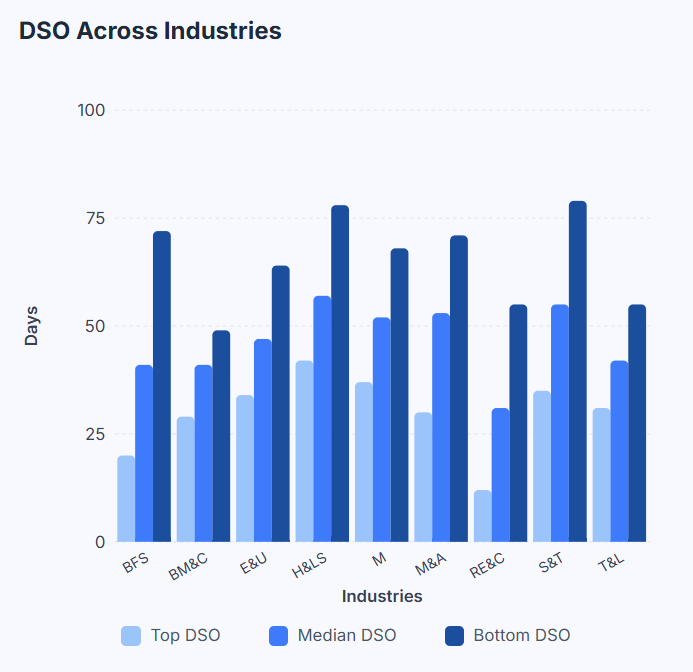Topics: Accounts Receivable Process, Finance & Accounting
Posted on July 21, 2025
Written By Siddharth Sujan

Getting paid on time is starting to feel like the exception, not the rule. Across the UK’s B2B landscape, finance teams are seeing a familiar pattern: invoices are going out, but the cash isn’t coming in fast enough. Accounts receivable days are getting longer, and the knock-on effects are starting to show in the form of tighter cash flow, slower decision-making, and growing pressure on working capital.
Yes, the economy plays a part. But what’s really holding firms back are the internal roadblocks like manual processes, slow credit checks and inconsistent follow-ups. These are the things that quietly stretch out days in accounts receivable, even when demand is strong and the books look good on paper.
In this blog, we’ll break down what’s actually driving those delays and how the right accounts receivable automation tools are helping UK finance leaders speed things up without adding more to their team’s plate.
At its core, accounts receivable days tells you how long it takes to get paid after you’ve made a sale. It’s one of those deceptively simple metrics that says a lot about the health of your finance operations.
The formula is straightforward:
Accounts Receivable Days = (Accounts Receivable ÷ Total Credit Sales) × Number of Days
But the meaning runs deeper. When average days in accounts receivable start climbing, it’s often a sign that your cash is getting stuck somewhere in the system. The longer that money stays out, the harder it is to stay agile—whether that’s paying suppliers, funding new projects, or just maintaining a healthy buffer.
Why it matters:
For many UK B2B businesses, getting paid is taking longer than it should. A closer look at what’s really holding things up reveals a mix of avoidable inefficiencies and habits that no longer serve fast-moving finance teams.
The bottom line? Rise in AR days can be attributed to both external and internal issues, and that means there’s real opportunity to fix them. Top-performing finance teams aren’t just waiting for the economy to improve. They’re using automation to reduce accounts receivable days and take back control of their cash flow.

If you’re still using spreadsheets, email chains, and manual trackers to manage collections, you’re leaving cash on the table. Automation helps eliminate the slow, error-prone steps that quietly stretch your accounts receivable days.
Here’s how it makes a difference:
RELATED CASE STUDY: Discover the automation fix that eliminated manual errors in high-volume receivables. Read the case study.
You don’t need to rip up your finance stack to fix collections. The fastest-moving B2B firms are trimming accounts receivable days by tightening a few key levers—here’s how:
Map your current AR process from quote to cash. Where are the slowdowns? Which steps are still handled in spreadsheets or email? This is where most firms spot hidden delays in accounts receivable days outstanding that never show up on reports.
Start where the pain is loudest—late invoices, missed follow-ups, or clunky credit checks. Use tools that integrate with your ERP so you’re not rebuilding everything. Even partial accounts receivable automation can make a huge difference.
Don’t just guess if it’s working. Measure shifts in average days in accounts receivable, follow-up turnaround, and on-time payments. Data will show you what’s improving and what still needs work.
Automation isn’t a silver bullet if no one’s using it right. Train your team on new workflows, and tell clients what’s changing on their end. The more transparent you are, the smoother the shift.
Automation doesn’t mean ‘set it and forget it.’ Use the real-time visibility to spot where cash is getting stuck. Tweak your rules, adjust reminder cycles, and keep refining until your accounts receivable days ratio starts moving in the right direction.
RELATED BLOG: Tired of chasing late payments? Check out these six practical strategies to put cash back in your hands!
The B2B firms making real progress on accounts receivable days aren’t just sending more reminders. They’ve fixed the deeper issues like messy processes and unclear ownership and replaced them with automation that works quietly in the background.
That’s where QX Global Group comes in. Our accounts receivable outsourcing services help UK finance teams modernise their setup, automate the repetitive work, and build systems that actually move the needle on cash flow. No overhauls, no disruption—just better visibility, faster collections, and fewer hours lost to chasing.
Want to see what this could look like in your business? Let’s start with a quick conversation.
It depends on your industry, but for most B2B firms, accounts receivable days between 30 to 45 is considered healthy. Anything higher may indicate delays in collections or weak credit control. If your accounts receivable days ratio is climbing month after month, it’s time to investigate.
Longer accounts receivable days slow down cash inflows, making it harder to cover expenses, invest in growth, or respond to new opportunities. When money stays stuck in unpaid invoices, your working capital takes a direct hit and forecasting becomes reactive.
Start by mapping your current accounts receivable process. Identify manual bottlenecks and look for automation tools that integrate well with your existing systems. Focus on key wins like automated invoicing, reminder triggers, and real-time dashboards. Train your team, set clear targets, and monitor your accounts receivable days improvement over time.
Use this simple formula:
Accounts Receivable Days = (Accounts Receivable ÷ Total Credit Sales) × Number of Days
This shows how long, on average, it takes to collect payment after a sale. A lower number generally means stronger collections and faster cash conversion.
It’s the same as calculating average days in accounts receivable. Divide your total accounts receivable by your average daily credit sales, then multiply by the number of days in the period.
Formula:
Accounts Receivable Days = (Accounts Receivable ÷ Total Credit Sales) × Number of Days
This tells you how long customers are taking to pay, on average.
Rearrange the DSO formula:
Accounts Receivable = (DSO × Total Credit Sales) ÷ Number of Days
This helps reverse-engineer your receivables number using days sales outstanding and total credit revenue.
Originally published Jul 21, 2025 04:07:42, updated Jul 29 2025
Topics: Accounts Receivable Process, Finance & Accounting